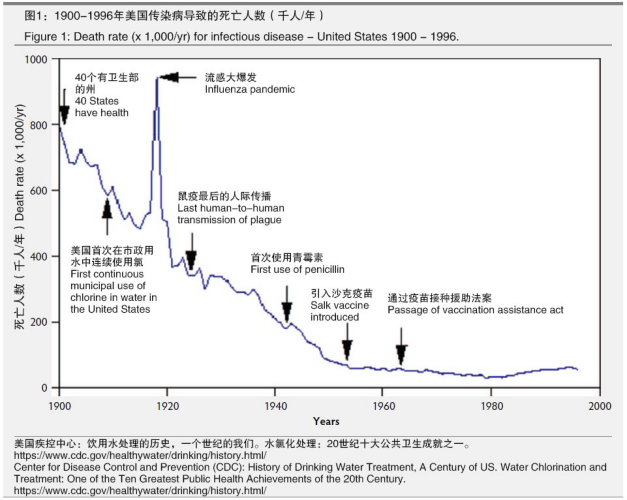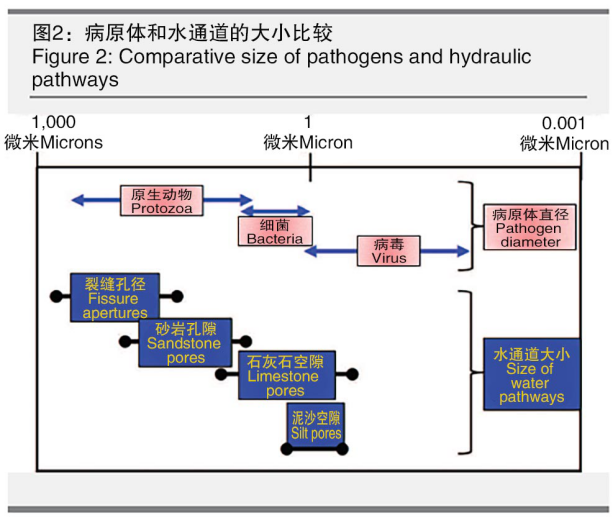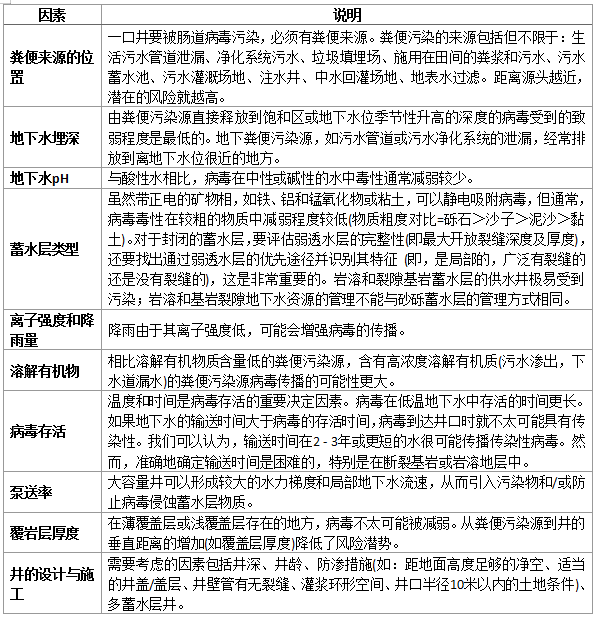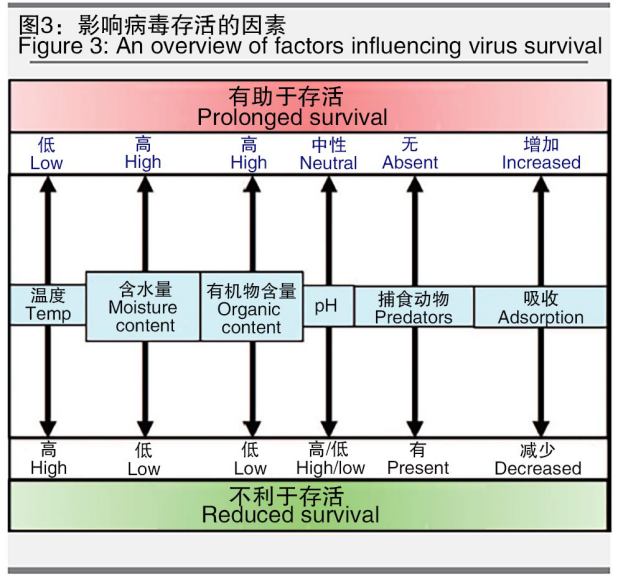猪场饮用水生物安全(一)- AASV 2020
来源:猪译馆 2020-05-21 15:34:40| 查看:次
译者的话<<
1908年美国公共供水系统(PWS)开始对饮用水进行消毒和处理。在接下来的十年里,美国成千上万的城市纷纷效仿。其结果是,因传染病而死亡的人数显著下降,这一下降也使得婴儿和儿童死亡率急剧下降,同时人均寿命增加了29.2年。公共供水的消毒和处理是20世纪公共卫生领域最伟大的成就之一2。
但如今,与美国公共饮用水供应相关的疾病爆发中仍有有50%以上是地下水中的病原体导致的,并且据美国疾病控制中心估计,公共供水系统中的病原体每年会导致3300万例急性胃肠炎发生。在2006年美国引入地下水法规(GWR)1之前,共卫生保护机构一直拒绝接受地下水可能含有病原体的事实。如今,农业行业也可能在地下水和生物安全方面有着类似程度的认知误区。
猪场饮用水生物安全(一)- AASV 2020
Groundwater Biosecurity for Livestock Production and Husbandry (Part 1) – AASV 2020
前言 Forward<<
作者 Authors:
Philip C. Olsen1; Steven J. Stone2, DVM
1Water Think Tank 公司创始人
2Fairmont 兽医服务公司
前言 Forward
关于疾病的起因和传播方式的错误认知非常多。有些情况下,这些错误认知在科学界是如此的根深蒂固,以至于任何对空气进行定量检测的建议都被贴上了可笑的标签。例如,有史以来,在疾病传播的背后有一个流行的观点,那就是瘴气理论,人们认为“污浊的空气”会在臭气熏天的地方引起疾病。约翰·斯诺对此持怀疑态度,当1854年伦敦爆发霍乱时,他有机会去做了调查。在他的研究中,他认为此次霍乱爆发与受污染的井水有关。然而,在2006年(152年之后)引入地下水法规(GWR)1之前,共卫生保护机构一直拒绝接受地下水可能含有病原体的事实。如今,农业行业也可能在地下水和生物安全方面有着类似程度的认知误区。
Misconceptions about what causes a disease and how it spreads have been very numerous. At times, so engrained in the scientific community, that to suggest anything quant air was branded as ludicrous. For instance, throughout history a prevailing idea behind disease transmission had been the miasma theory and “bad air” was thought to cause disease in areas that contained a bad stench or aura of sickness. John Snow was skeptical of this and when a cholera outbreak occurred in London in 1854, he had a chance to investigate. In his study, he was able to link the outbreak to contaminated well water. Yet, public health protection agencies continued to reject the possibility of groundwater containing pathogens until the introduction of the Ground Water Rule (GWR)1 152 years later in 2006. Today the agricultural industry may possess a similar level of hubris regarding groundwater and biosecurity.
值得注意的是,1908年公共供水系统(PWS)开始对饮用水进行消毒和处理。在接下来的十年里,美国成千上万的城市纷纷效仿。其结果是,因传染病而死亡的人数显著下降,如图1所示2。这一下降也使得婴儿和儿童死亡率急剧下降,同时人均寿命增加了29.2年。公共供水的消毒和处理是20世纪公共卫生领域最伟大的成就之一2。
A note of interest is in 1908 public water systems (PWS) began disinfection and treatment of drinking water. Over the next decade, thousands of cities across the United States followed suit. As they did, the number of deaths from infectious diseases declined markedly as shown in Figure 12 . This decline contributed to a sharp drop in infant and child mortality and a 29.2-year increase in life expectancy. Disinfection and treatment of public water supplies represents one of the greatest achievements in public health of the 20th century 2.
图1:1900-1996年美国传染病导致的死亡人数(千人/年)

注:美国疾控中心:饮用水处理的历史,一个世纪的我们。水氯化处理:20世纪十大公共卫生成就之一。https://www.cdc.gov/healthywater/drinking/history.html/
Center for Disease Control and Prevention (CDC): History of Drinking Water Treatment, A Century of US. Water Chlorination and Treatment: One of the Ten Greatest Public Health Achievements of the 20th Century. https://www.cdc.gov/healthywater/drinking/history.html/
一级和二级消毒
Primary and secondary disinfection<<
在此期间,技术、工程设计标准和性能认证/验证程序得到了完善,以确保进入饮用水配水系统(管网)中的水从微生物的角度来说是安全的,这些做法被称为一级消毒,也是本文所讲述的内容(生物安全)。二级消毒确保水在经过配水系统输送之后仍然没有病原体,这部分内容将在后续的文章中讲述。
During this period technologies, engineering design standards, and performance validation/verification protocols became well established to ensure water entering a drinking water distribution system is microbiologically safe, this practice is referred to as Primary Disinfection and addressed within this paper (Part 1). Secondary disinfection ensures water remains absent of pathogens as it travels through a water distribution system and will be addressed within a subsequent paper (Part 2).
肠道病毒 Enteric viruses<<
人类和动物排泄物中有100多种致病病毒。这些病毒可以通过地下水蓄水层在环境中传播。通过粪-口途径传播,主要在宿主的胃肠道内感染和复制的病毒统称为肠道病毒。这些病毒在受感染者的粪便中大量散播,通常每克粪便中有105至1011个病毒颗粒4。
Over 100 types of pathogenic viruses are excreted in human and animal wastes. These viruses can be transported in the environment through groundwater aquifers. Collectively known as enteric viruses, are transmitted via the fecal-oral route and primarily infect and replicate in the gastrointestinal tract of the host. Such are shed in extremely high numbers in the feces of infected individuals, typically between 105 and 1011 virus particles per gram of stool.4
肠道病毒可通过食物、水、污染物和人际接触传播。它们除了能引起急性疾病外,由于其感染剂量低,还会引起公共卫生问题。例如,暴露于一种轮状病毒的感染概率为31%,并且不足一个噬菌斑形成单位数的病毒量就可以导致1%的健康成年感染。当通过饮用水摄入病毒时,感染的风险比在类似暴露条件下致病菌的感染风险高出10至10000倍。由于潜在的污染来源非常多,水中的肠道病毒尤其令人担忧。自20世纪80年代以来,随着在环境病毒学领域取得的重大进展,肠道病毒已被确认为导致许多非细菌性肠胃炎病例和爆发的病原体4。
Enteric viruses can be transmitted by food, water, fomites, and human contact. In addition to causing acute diseases, they are of public health concern due to their low infectious dose. For example, the probability of infection from exposure to one rotavirus is 31%, and no more than 1 plaque-forming unit (PFU) is required to cause infection in 1% of healthy adults. The risk of infection when consuming viruses in drinking water is 10- to 10,000-fold greater than that for pathogenic bacteria at similar exposures. Because of the potential for contamination from a variety of sources, enteric viruses in water are of particular concern. Since the 1980s, with significant advancements in the area of environmental virology, enteric viruses have been recognized as the causative agent in many nonbacterial gastroenteritis cases and outbreaks.4
肠病毒和腺病毒是作为潜在水质指标研究最多的两种肠道病毒。虽然人类肠道病毒在环境中的发生及其在水媒传播中的作用已被广泛研究,但关于动物肠道病毒在环境中的传播信息却很少。虽然70%(62种血清型)的非脊髓灰质炎肠道病毒与人类感染有关,但还有30%与动物感染有关。牛和猪等宿主的动物特异性肠病毒感染通常无症状,但可能导致从腹泻到生殖功能衰竭和神经系统疾病等一系列疾病。目前已鉴定出2种牛肠病毒(BEV)、3种猪肠病毒(PEV)、11种猪捷申病毒(PTV)(其中有10种以前被归类为猪肠病毒)和1种绵羊肠病毒。
Two of the most studied groups of enteric viruses as potential water quality indicators are the enteroviruses and adenoviruses. While the occurrence of human enteric viruses in the environment and their role in waterborne transmission have been studied extensively, little information is available on environmental transmission of enteric viruses in animals. Although, while 70% (62 serotypes) of nonpolio virus enteroviruses have been associated with human infections, 30% have been associated with animal infections. Animal-specific enterovirus infections in hosts such as cattle and pigs are often asymptomatic but may cause diseases ranging from diarrhea to reproductive failure and neurological disorders. Two bovine enteroviruses (BEV), three porcine enteroviruses (PEV), 11 porcine teschoviruses (PTV) (10 were formerly classified as porcine enteroviruses), and 1 ovine enterovirus have been identiied.4
大多数的研究是针对感染人类而非猪的病原体。本文所涉及的研究是针对病毒的总体生存能力和传播能力。猪肠病毒在家猪和野生猪中的患病率为65%。猪肠病毒和猪捷申病毒已被确定为是导致一种猪神经系统疾病的病原,该疾病会表现为:捷申病、脑脊髓灰质炎、水疱病、心肌炎、肺炎、腹泻、繁殖障碍和猪皮肤病变的。5种猪腺病毒(PAdV)、5种牛腺病毒(BAdV)和6种绵羊腺病毒已被归为哺乳动物腺病毒属。此外,在患有脑炎和肺肠炎的猪中分离出了猪腺病毒。
While most studies are specific to pathogens infectious to human vs. swine populations. The question of address in this paper is related to the survivability and transport of virus in general. Though, PEV have a prevalence of 65% in pigs and wild hogs. PEV and PTV have been identified as the etiologic agents of the neurological disorder known as Teschen-Talfan disease, polioencephalomyelitis, vesicular diseases, myocarditis, pneumonia, diarrhea, fertility disorders, and dermal lesions in swine. Five porcine adenoviruses (PAdV), five bovine adenoviruses (BAdV), and six ovine adenoviruses have been classified under the genus Mast adenovirus. PAdV also has been isolated from pigs with encephalitis and pneumoenteritis.4
地下水中的肠道病毒
Presence of enteric viruses in groundwater<<
2006年之前进行的大量同行评审研究证实了地下水是传播疾病的重要媒介,这些研究随后成为了制定地下水法规的基础,并纳入了美国《安全饮用水法》(SDWA)5。现在地下水法规代表了一个可强制执行的标准,以保护使用公共供水系统的人群的健康。
A plethora of peer-reviewed research conducted in advance of 2006 served to validate groundwater as a significant vehicle for disease transmission and subsequently served as the foundation from which the GWR was formulated and included within the US Safe Drinking Water Act (SDWA).5 The GWR now represents an enforceable standard to protect the health of individuals connected to PWS’s.
如今,与美国公共饮用水供应相关的疾病爆发中有50%以上仍然是地下水中的病原体导致的,并且据美国疾病控制中心估计,公共供水系统中的病原体每年会导致3300万例急性胃肠炎发生。以下研究(通过参考)进一步证实了在地下水蓄水层中存在传染性病毒7-22。
Although, the presence of pathogens in groundwater still accounts for more than 50% of disease outbreaks related to public drinking water supplies within the United States6 and the CDC estimates up to 33 million cases of acute gastroenteritis illnesses occur each year due to the presence of pathogens within US PWS’s. The following studies (by reference) provide further validation for the presence of infectious virus within groundwater aquifers.7-22
蓄水层中病毒的进入、转移和空间扩散
Virus entry, travel and spatial dispersion in aquifers<<
相对于土壤和未固结的沉积层中的间隙/空隙空间(表2和图2)来说,病毒颗粒是非常小的(表1),因此病毒很容易通过土壤和整个蓄水层转移。一些研究人员报告说,病毒主要通过优先途径传播。为了帮助强调地表水来源内的病原体如何有效地转移到蓄水层,据估计,多达96%的水通过仅0.32%的土壤通过优先途径运输52。由于地表和地下土壤和地质结构中存在的一些结构23,可以帮助形成优先流动途径,这些途径可以非常迅速地将水和污染物带到深处,从而对水质产生比以前预期的更大的影响23。
Due to their size (Table 1) relative to the interstitial (void) space(s) within soils and unconsolidated sedimentary layers they pass through (Table 2 & Figure 2) virus are easily transported through soils and throughout aquifers. Several researchers have reported viruses primarily travel through preferential pathways. To help emphasize how efficiently pathogens within surface water sources may be transported into aquifers, it is estimated that up to 96% of water is transported through only 0.32% of the soil volume via preferential pathways.52 Pathways of preferential low can develop due to structures present in surface and subsurface soils and geologic structure(s)23 and serve to carry water and contaminants to depths very rapidly, resulting in greater impact on water quality than previously expected.23
表1:病毒颗粒大小
Table 1: Size of virus

来源:大英百科全书
Source: Britannica
表2:土壤和蓄水层中的水通道的大小
Table 2: Size of hydraulic pathways within soils and aquafers

来源:美国土壤局
Source: US Bureau of Soils
图2:病原体和水通道的大小比较
Figure 2: Comparative size of pathogens and hydraulic pathways

这些水通道可减少微粒(病毒)与土壤之间发生的潜在相互作用,这些相互作用与下列机制有关:A.) 吸附、B.) 布朗运动、C.) 离子交换、D.) 沉积、E.) 尺寸排阻、F.) 表面电荷(+/-)、E.) 范德瓦尔斯力。
Such hydraulic pathways serve to reduce potential interactions from occurring between particulates (virus) and soils related to the following mechanisms: A.) Adsorption, B.) Brownian motion, C.) Ion exchange, D.) Sedimentation, E.) Size exclusion, F.) Surface charge (+/-), and E.) Van Der Waals (forces).
由于流体力学的原因,优先路径也会阻止颗粒(病毒)从液体流动的通道中流出,而其他力则会导致水的析出。这些力量包括:A.) 渗透压(低→高浓溶液);作用——析水量取决于地下水离子浓度与被输送的水(通常是地表水)之间的差异。当水被析出时,微粒和病毒并没有析出,导致它们在这些途径中剩余的水内的浓度增加。由于地下水的导电性(离子强度)通常与高浓度的钙、镁、硫酸盐和氯化物有关,所以对这种现象的敏感性通常与这些离子的高浓度有关。B.) 毛细力;作用——地下土壤颗粒间(和颗粒内部)的间隙越小,在颗粒内部吸引和保留液体的力就越大。这将影响水迁移到微粒和病毒不能到达的地方。反过来,这也有助于优先途径脱水和病毒集中。此外,诸如微生物(病毒)之类的微粒是以胶质的形态转移的52。因此,它们不会沉淀,也不能通过上述机制从水中去除,这就促使它们能转移到蓄水层并在整个蓄水层内迁移。
Due to the mechanics of fluid dynamics, preferential pathways also prevent particles (virus) from exiting channels of liquid flowage while other forces cause the extraction of water. These forces include: A.) Osmotic pressure (Low → High concentrate solutions); Effect –the amount of water extracted is dictated upon the difference in ionic concentration of groundwater verses the water being transported (typically surface water). As water is extracted, particulates and virus are not, causing their concentration within the remaining volume of water within such pathways to increase. Because ground water conductivity (ionic strength) is typically associated with higher concentrations of calcium, magnesium, sulfates and chlorides, susceptibility to this phenomenon is typically associated with higher concentrations of these ions. B.) Capillary Force; Effect – the smaller the interstitial spaces between (and within) granules of subsurface soils, the greater the force becomes to attract and retain fluids within them. his will affect water to migrate into areas where particulates and virus cannot. In turn, this also serves to dewater preferential pathways and concentrate virus. In addition, particulates such as microorganisms (virus) are transported as colloids.52 Accordingly, they will not settle and cannot be removed from water by the mechanisms described above and facilitates their transport to (and throughout) drinking water aquafers.
这些现象将在下面的参考文献中进一步描述10、24-29。有研究报告证明病毒可能在几周内从污染源转移到220 ~ 300米深的市政井21,而在裂隙基岩中的转移仅需几个小时30。
These phenomena are further described within the following references. 10、24-29 Studies report virus may be transported from a contaminant source to municipal wells that were 220 to 300 meters deep within a matter of weeks21 and on the order of hours in fractured bedrock.30
致病病毒通过土壤和地质地层进入蓄水层的可能性似乎比致病菌和原生动物要大得多,它们可以存活很长一段时间9,32,可以长途迁移33。除了上述情况外,表3还列出了影响地下水蓄水层内病毒进入和传播的一些因素。
Penetration of pathogenic viruses through soils and geological strata into aquifers seems much more likely than for pathogenic bacteria and protozoa31 and survive for extended periods of time9,32 and transported over long distances.33 In addition to what is described above, Table 3 provides a selection of factors that influence virus entry and travel within groundwater aquifers.
表3:影响病毒进入和通过蓄水层传播的因素
Table 3: Factors that influence virus entry and travel throughout an aquifer

另外值得注意的是,由于病毒独特的遗传特征,加上我们目前对它们进行微量检测的能力,流行病学家现在正在考虑使用临床数据作为一种手段来跟踪蓄水层中随时间(≤3年)的病毒病原体量。这些数据可以呈现受感染猪群的病毒情况。其中,当与病毒病原体的存在相关时,如在局部地下水来源内测量,可作为跟踪病毒和地下水转移的标记34。
An additional note of interest is due to their unique genetic signatures, coupled with our current ability of detecting them in trace quantities, epidemiologists are now considering the use of clinical data as a means of tracing plumes of viral pathogens in aquifers over time (≤ 3 years). Such data sets produce virus “snapshots” of infected populations. Wherein, when correlated with the presence of viral pathogens, as measured within localized groundwater sources, serve as a marker for tracking virus and groundwater movement.34
地下水中病毒基因组的存在表明,病毒在蓄水层中转移的时间为2至3年35。病毒在地下水中存活的保守估计是3年32,而合理的估计是1至2年9。图3概述了影响病毒存活的因素。
The presence of viral genomes in groundwater demonstrate travel times in aquifers of two to three years.35 A conservative estimate for virus survival in groundwater is three years, whereas32 a reasonable estimate is one to two years.9 Figure 3 provides an overview of factors influencing virus survival.
图3:影响病毒存活的因素
Figure 3: An overview of factors influencing virus survival

服务热线:400-808-6188
Copyright©2010-2022 https://www.zhuwang.cc